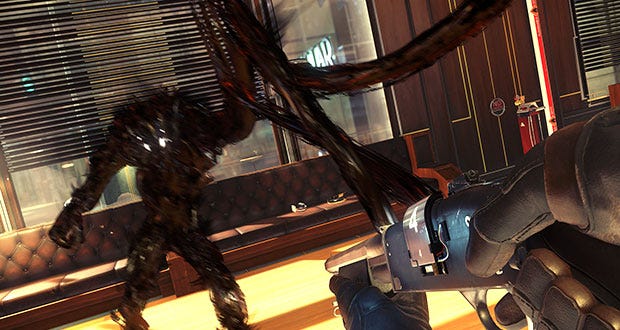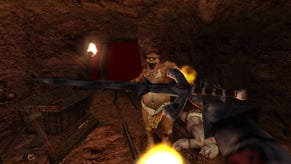Prey: hands-on with Arkane's shapeshifting shooter
The TruMorgan Show
The game I was most reminded of when playing the opening hour of Arkane's upcoming sci-fi shooter Prey [official site] was Deus Ex: Invisible War. No, don't panic.
I'm going to talk fairly frankly about what happens in this first hour of the game, as dancing around it for fear of spoilers would leave me with little useful to say. In other words, here be spoilers. If you want to go into totally blind then fair enough, walk on friend - but I promise I'm only talking about the first hour, as I've not seen anything beyond that. At the other extreme, if you want to know everything but don't want to read all these damn words, here's a full recording of my play session for you to watch.
Though it shares Dishonored's generous servings of incidental environmental detail, Prey almost immediately goes out of its way to demonstrate that it is not simply a sci-fi version of Arkane's other, more steampunkish series. We're in the year 2032, or so we're told, in a high-rise apartment on Earth, or so we're told.
After a quick choice between a male or female protagonist - who is named Morgan Yu and has the same abilities and capabilities whichever you choose - we're given freedom to poke around his or her fancy pad on a bright and sunny morning. While the game doesn't make any overt reference to which variant of Yu you chose, I did notice that, because I'd gone for the woman option, there was a necklace hanging by the sink and heeled shoes by the door - a neat and subtle touch.
The flat's a treat to nose around too. High-level science books placed just-so (alright, alright, we get it, you're smart), Alexa-style systems controlling the apartment, ice-cool future-music playing, the view outside the window suggesting a healthy and ordered society (guess everything turns out OK, huh?). You can pick up and throw around almost anything, treat yourself to a glug of breakfast wine and, yep, the toilet flushes. While later sections of the game see it move closer to BioShock than System Shock, you can certainly tick off a few boxes on your immersive sim bingo chart.
There's no hurry, but a character called Alex Yu - an email on a nearby computer suggests he's Morgan's sibling - whose voice sound suspiciously like that of Breaking Bad's Jonathan Banks calls up chummily to say that Morgan should head to their shared workplace. There's a helicopter on the roof, and already I'm thinking Deus Ex and how its initially quasi-corporate heroes get their own private choppers, then we're treated to a dramatic flyby over the city. It's a decent futurescape, clean and shining, closer to Mirror's Edge than Blade Runner, though nothing like as stylised.
For all this, I'm not getting an especially clear sense of place, and this is true throughout the session. Even though Prey repeatedly goes out of its way to show me incredible detail and striking setpieces, it didn't communicate anything like the same sense of thereness as Dishonored's suffering city of Dunwall does. Though there are plot-based reasons for sudden switches in environmental style, the first hour did come across as a selection box of aesthetics rather than one overarching visual language. For this reason, it's hard to get a bead on what Prey's vibe is - but hopefully it settles down and pursues something more singular later on.
I digress. Prey has its own smart take on the tutorial, which sees Morgan a willing participant of unspecified lab tests that investigate, among other things, his/her understanding of how to hide, rapidly traverse the environment and use in-game PCs. This is followed by a Voight-Kampff-style morality/empathy test-cum-Kobayashi Maru impossible choice dilemma. No consequences of your choices are detailed, but whether or not they come to bear later, what this does do, together with a few cryptic comments from your watching colleagues, is convey that there's more than meets the eye to what's going on.
Clever clogs who've picked up on this stuff only get a few moments to celebrate their perception before Prey pulls back the curtain - or, at least, a curtain. I won't go into complete detail, but you can catch every moment of it in the video here. Short answer though: Morgan is even more of a labrat than she realised, having been unwittingly living out some groundhog day scenario in which her apartment, workplace and even the cityscape seen from the helicopter were all part of an elaborate, monitored Truman Show facade.
It's in these slow reveals that the visual design is most successful - showing the shifting walls of the complex she's been kept within, the theme park pistons and motors that made the helicopter ride feel real, and the darker, more ramshackle behind-the-scenes rooms.
Prey's trump card, in what I've seen, is paranoia. Every aspect of Morgan's life, shown to us in painstaking detail (presuming we chose to look at it) is a lie, with what few characters we've met so far a key part of the deception. A helper character soon makes themselves known, but my memories of both Bio and System Shock couldn't help but cast suspicion on them too. Turns out, I rather like not trusting anything or anyone - though systems-wise Prey is more action-centric than either System Shock or Deus Ex, it certainly has something of their tone.
Again though, it's Deus Ex's first, unloved sequel Invisible War that I was most reminded of, which also sees its protagonist's apparently comfortable life in a well-equipped future-apartment turn out to be part of an elaborate experiment run by apparently sinister forces. There are a great many similarities in Prey's opening feint, and it's worth knowing that Arkane's Harvey Smith was a major force on the Invisible War dev team - though it must be said that Prey is handled by Raphael Colantonio's Austin branch of Arkane, whereas Smith's Lyon team was busy working on Dishonored 2.
The similarities soon fade, however, as Prey broadly becomes a BioShock-style action game set within a large but contained, monster-filled environment, rather than depositing you on the streets with a choice of shooting, speaking or stealthing your way to success. Turns out we're in space, and there are tar-like, shapeshifting aliens all over the place - able to transform into various innocuous objects, an ability they use both to hide from you and to ambush you.
Sadly, the much-ballyhooed 'turn into a a cup' hero powers were not available in this build, but the xenos were certainly at it. By and large, I didn't find that the hiding presented a new strategic challenge per se, but it does remix the flow into something quite different from the shooter norm. Headcrab-like enemies that emerge from nowhere, then scuttle away and disguise themselves before you can hunt them down - there's a sort of call and response element to combat. Ah you bastard, I'll get you, wait where did you go, aaaah not again, OK starts randomly thumping everything.
A little later on, we get the GLOO weapon, Prey's own slightly contrived attempt to have its own Gravity gun, which can temporarily stick the little bleeders in place. Useful both for stopping them doing the Decepticon thing and for simply slowing them down, as they're damned fast. Larger, bipedal variants turn up before too long as well - deadlier and harder to contain for sure, though I'm yet to get a handle on whether they have increased transformation powers.
Another comparison - the all-black, almost fractal enemies put me slightly in mind of the weird, shifting monolith creatures in 2K Australia's doomed first pass on the game that eventually became The Bureau: XCOM Declassified. Those were striking beasties, though did raise the question of whether fighting a big rectangle could be all that much fun.
Prey answers this by making a faintly similar concept more conventionally monstrous, but without their hiding-in-plain-sight powers I'm not sure how much of an impression these creatures would make. They began to feel routine oddly quickly, but fingers crossed these tarballs become more visually interesting as the game wears on - and that Prey drops some bombs about their true nature.
In the absence of access to my own shapeshiting powers, it's the GLOO gun that opened up the widest array of possibilities. I will admit that, because my own mind is often barren of creative instincts, this particularly penny did not drop until a Bethesda staffer expressly told me that, if you shoot it at a wall or ledge, the GLOO can create solid platforms that you can jump or mantle onto.
And so it was that I essentially built my way to hitherto out of reach areas, both to make shortcut to objectives and to access secrets - a little bit of Minecraft inside a glossy action game. The GLOO gun does come across as a touch gimmicky, a bit Back Of The Box Feature, but hey, in these po-faced military shooter times I most definitely do not object to a resurgence of mid-noughties silliness.
Outside of that and the shooting, there was a strong emphasis on hunting for keycards and door codes in the age-old 'Shock Ex paradigm. It's here that the otherwise faint Dishonored similarities most revealed themselves, and it's a structure which does now feel familiar - though combing together faint pictures of people's lives by reading their email or eyeballing all the meticulous detail in their offices remains a key strength, and the main way in which Prey is not 'just' a shooter. Hopefully Prey can sustain sufficient variety of alternate methods to navigate through and to closed environments, and I suspect that's going to come down to the 'alien' powers I didn't get to dabble with.
I did get to choose between, speaking very broadly here, hacking, crafting and combat abilities which, among other things, would allow me to progress by e.g. repairing broken lifts, improving my gear or bypassing security. Very Deus Ex, but with an added crafting element - for instance, I can lob all sorts of junk, from banana skins to circuit boards, into a recycler that converts them into nuggets of various raw materials I can then build with it. There wasn't too much available to experiment with in that regard in my hour, but it speaks to later possibilities.
Basically, the opening laid a certain amount of groundwork for how I believe Prey will play it out later on, which is to say plenty of freedom to move around a very large space station space in an order and method of your choosing. It's the sense of uncertainty which most appealed to me though, the creeping awareness that nothing can be trusted. Perhaps not even yourself, with the session culminating in another curtain-pull that goes Full Total Recall.
I simultaneously feel as though I know exactly what Prey is and that I'm still in the dark about its true nature. Keycodes and goobeasts vs a pile of ambitious do-it-yourself features and a world I can't trust. There's a lot going on here, many intriguing questions posed and its essential exploration+combat balance feels good in the hand, but I'm still waiting to see precisely which shape Prey ultimately takes.
Prey is due for release on May 5 this year. Here's a video of what I played so you can get a sense of it for yourself - my plan is to put up a second version with narration on what I'm doing and what I think in due course.
























